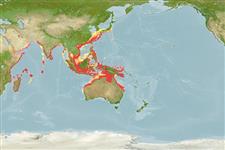Common names from other countries
Élasmobranches (requins et raies) (sharks and rays) >
Carcharhiniformes (Ground sharks) >
Carcharhinidae (Requiem sharks)
Etymology: Carcharhinus: karcharos (Gr.), sharp or jagged; rhinus, an ancient name for sharks, from rhine (Gr.), rasp, both words alluding to a shark's jagged, rasp-like skin. (See ETYFish); macloti: In honor of German naturalist Heinrich Christian Macklot (1799-1832, Latinized as Maclot), who collected holotype in New Guinea. (See ETYFish).
More on authors: Müller & Henle.
Environment: milieu / climate zone / depth range / distribution range
Écologie
marin démersal; profondeur ? - 170 m (Ref. 6871). Subtropical; 37°N - 27°S, 39°E - 154°E
Indo-West Pacific: Kenya, Tanzania, Pakistan, India, Sri Lanka, Andaman Sea, Myanmar, Viet Nam, China, Taiwan, Hong Kong and the Philippines (Ref. 6821), New Guinea. Also in the Arafura Sea (Ref. 9819). Possibly occurring in the Gulf of Aden (Ref. 9997).
Length at first maturity / Taille / Poids / Âge
Maturity: Lm 72.3, range 70 - 89 cm
Max length : 110 cm TL mâle / non sexé; (Ref. 6871)
Épines dorsales (Total) : 0; Épines anales: 0. A small slender shark with a long narrowly rounded or somewhat pointed snout, no interdorsal ridge, small pectoral fins, a small first dorsal fin with an extremely long rear tip and a small low second dorsal fin with a long rear tip (Ref. 244). Back grayish or grey-brown, belly white; posterior margin of pectorals and ventral caudal fin lobe with an inconspicuous white edge; posterioventral and dorsal margins of caudal fin with a narrow black edge (Ref. 9997).
Found in inshore and offshore waters of continental and insular shelves (Ref. 9997). Feeds mainly on fishes, also cephalopods and crustaceans (Ref. 6871). Viviparous (Ref. 50449). Of limited interest to fisheries due to its small size (Ref. 9997). Utilized fresh and probably dried-salted for human consumption (Ref. 244).
Viviparous, placental (Ref. 50449). 1 or 2 (usually 2) in a litter (Ref. 244). Size at birth 45 to 50 cm TL (Ref. 9997). Distinct pairing with embrace (Ref. 205). 12 months gestation period (Ref.58048).
Compagno, L.J.V., 1984. FAO Species Catalogue. Vol. 4. Sharks of the world. An annotated and illustrated catalogue of shark species known to date. Part 2 - Carcharhiniformes. FAO Fish. Synop. 125(4/2):251-655. Rome: FAO. (Ref. 244)
Statut dans la liste rouge de l'IUCN (Ref. 130435)
Utilisations par l'homme
Pêcheries: intérêt commercial mineur
Outils
Articles particuliers
Télécharger en XML
Sources Internet
Estimates based on models
Preferred temperature (Ref.
115969): 24 - 29.1, mean 28 (based on 2308 cells).
Phylogenetic diversity index (Ref.
82804): PD
50 = 0.5000 [Uniqueness, from 0.5 = low to 2.0 = high].
Bayesian length-weight: a=0.00437 (0.00261 - 0.00730), b=3.07 (2.93 - 3.21), in cm Total Length, based on LWR estimates for this species & Genus-body shape (Ref.
93245).
Niveau trophique (Ref.
69278): 4.2 ±0.4 se; based on diet studies.
Résilience (Ref.
120179): Très faible, temps minimum de doublement de population supérieur à 14 ans (Fec=1).
Fishing Vulnerability (Ref.
59153): High to very high vulnerability (66 of 100).
